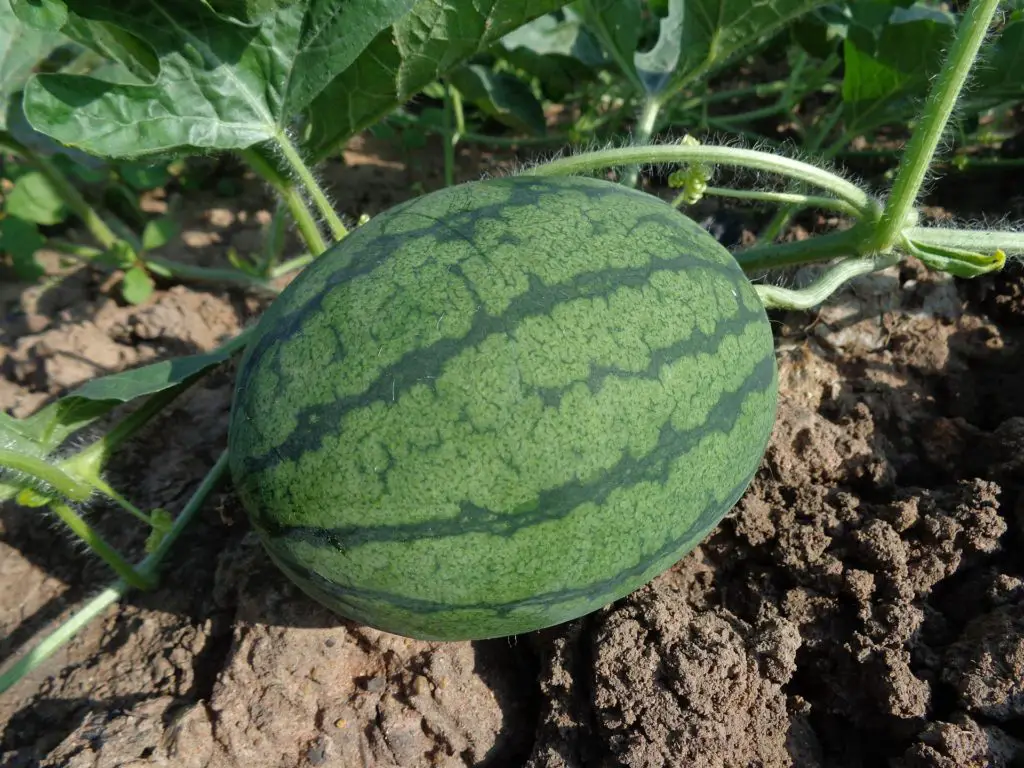One of my favorite things to plant in our garden each year is watermelon because they are fairly easy to grow and a family favorite in the summer months. Plus, everything is better homegrown, right? Watermelons do take up a lot of room in a garden with vines growing up to around 12 feet long, so many people wonder what type of watermelon they should plant and how many watermelons per plant they can expect. There are actually many different types of watermelon making it fun to try several different varieties and find out which ones you like the best.
Each healthy plant will likely produce 2 – 4 watermelons per plant on average with consistent watering, fertilizing, and two to three months of growth in heat. If you start with seeds, your watermelons will reach maturity in about 75 to 85 days. If you start with a plant from your local nursery, you will cut your wait time for harvest down by a few weeks. You may even want to plant some seed and some plants to try out your green thumb with both.

Common types of watermelon:
There are hundreds of varieties of watermelon and it’s hard to know the difference between them all. We are sharing the most common types of watermelons and the different varieties that you may see in your local stores or farmers markets.
Seedless Watermelon
Seedless watermelon did not just happen, but instead were created through cross breeding two different types of watermelon to produce a variety that is incapable of producing seeds. If you want to grow seedless watermelons it is important to know that they still must be pollinated by their seeded parent, so you should plant seeded watermelons as well. Thankfully seedless watermelons are still that wonderful sweet flavor that we all love.
Picnic Watermelon
Picnic watermelon, which you are probably most familiar with, are larger and can be anywhere from 15 to 75 pounds depending on the variety. These watermelons were named for their size, enough to feed a larger group at a picnic or bbq.
Icebox Watermelon
Icebox watermelons are the same as the watermelons that are used to, just smaller in size. In fact, they get their name from their size as they are smaller and easier to fit in the fridge or a cooler. They still have that red color and sweet flavor that you expect from a watermelon.
Yellow/Orange Fleshed Watermelon
Yellow or orange fleshed watermelon may appear the same on the outside, but inside the difference is obvious. These watermelons get their color from a lack of a carotenoid called lycopene. They also come in both seeded and seedless varieties and are a little sweeter than red varieties with a honey-like flavor to them.
| Types | Varieties | Maturity | Size |
|---|---|---|---|
| Seedless | Queen of Hearts King of Hearts Millionaire Jack of Hearts Crimson Trio Nova | 85 days | 10 to 20 pounds |
| Picnic | Charleston Gray Crimson Sweet Jubilee Black Diamond Allsweet | 85 days | 16 to 75 pounds |
| Icebox | Sugar Baby Tiger Baby Petite Sweet Orchid Sweet Red Doll | 75 days | 5 to 15 pounds |
| Yellow/Orange Fleshed | Tender Gold Yellow Baby Yellow Doll Desert King | 75 days | 5-20 pounds |
How to grow watermelon
If you have never grown watermelon, you may have a few questions about how to successfully grow healthy plants. The good news is that they are fairly easy to grow and require little maintenance. In fact, if you are a beginner in the garden, watermelon is a great plant to start with. Here are some tips to grow delicious watermelon this summer:
- Planting the seeds. Once the outside temperature reaches around 70 degrees with no cold nights in the forecast, it is safe to go ahead and plant your watermelon.
- Add compost. Because watermelons are heavy feeders, it is recommended that you add compost to the soil when you plant your seeds for those delicious watermelons.
- Use mulch. Mulch is a great addition to a garden with watermelon as it helps the plants to retain their moisture and keep the weeds out.
- Straw bed. Adding straw under the watermelons as they start to grow can help to prevent rot from moisture on the ground or diseases.
- Consistent watering. Watermelons are made up of mostly water, so it makes sense that they need plenty of water. It is best to ensure your plants get 1 to 2 inches of water per week.
- Fertilize. Remember that watermelons are heavy feeders so regular fertilizing can be really beneficial. Use your own compost or a store bought fertilizer for fruits and vegetables.
What types of watermelon to plant
What type of watermelon you plant depends on how many people will be eating them, seed preference, and flavor. One thing to consider is the time it takes each type to mature. You will likely want to plant watermelon varieties that have different harvest times so that your melons are not ready all at once. Seedless and picnic watermelons, for example, have longer grow times than icebox and yellow/orange fleshed watermelons. Doing this will keep you stocked with delicious watermelon for several weeks.
Is watermelon a fruit?
Watermelon is a fruit because it develops from the flower and holds the seeds. It is from the gourd family and is a great source of vitamin C and vitamin A. This question is also frequently asked about peppers, tomatoes, and pumpkins which are also all fruits. A vegetable comes from other parts of the plant like the leaves or carrots which are the root of the plant.
Conclusion
Now that you know you can expect 2-4 watermelons per plant, it’s time to figure out how many fruits you hope to have in your garden and get started planting. Remember, you can also pick up plants rather than seeds and cut your wait time to harvest down by several weeks. Whether you choose seeds or already started plants, growing watermelon is rather easy and even more rewarding. There are so many wonderful varieties to try and by following the simple growing tips above, you’ll be enjoying the fruits of your labor in no time!
